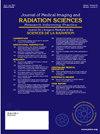利用放射技师的意见来减少放射科的错误。
IF 1.3
Q3 RADIOLOGY, NUCLEAR MEDICINE & MEDICAL IMAGING
Journal of Medical Imaging and Radiation Sciences
Pub Date : 2025-01-01
DOI:10.1016/j.jmir.2024.05.005
引用次数: 0
摘要
简介:放射技师评论是放射技师在采集图像时对医学影像检查中发现的疑似异常情况进行的书面说明。放射技师评论最初是为了支持急诊临床医生而实施的,但也有可能支持放射医师减少漏诊。因此,本研究旨在探讨新实施的放射技师评论系统能否减少普通 X 射线放射报告中的错误数量。多地点合作研究的偶然发现提出了一个假设,即在某些情况下,放射技师的评论可以准确发现放射医师报告中没有记录的异常 X 光片,从而可以修改结果并共同减少错误[1]:本研究在一家拥有 800 张床位的医院进行,92% 的普通放射技师自愿参加。放射技师的意见通过电子病历提供给转诊医生,可用于任何急诊或住院普通 X 光检查。在 12 个月内提出的所有意见都要与相应的放射科医生报告进行核对。放射科医生在报告时对放射技师的意见是保密的。如果放射技师的评论与放射医师的报告之间出现差异,则会使用放射医师的补充审查或后续成像报告来确定准确的解释。与放射科医生的报告相比,放射科医生的意见被视为真阳性 (TP),并提供了新的、正确的诊断信息。这些意见被转换成放射技师意见总数的百分比,从而对放射技师报告的准确性产生积极影响。此外,还测量了放射技师意见被视为假阳性(FP)的差异病例数量,并将其转换为占总意见的百分比。使用 Wilson Score Interval 计算了 TP 和 FP 二项比例的置信区间:在 12 个月内,共有 282 条放射技师意见提醒普通 X 光片上有临床意义的影像学表现。其中有 32 条放射技师意见与报告不符。在这 32 条意见中,有 24 条被认为是 TP,这意味着它们正确识别了放射学报告中没有记录的病理影像。因此,在所有的放射技师意见中,有 8.5% 的意见通过正确识别病理而增加了价值,95% CI (5.8% - 12.4%)。这样就能及时修正结果,共同减少报告错误。相反,有八条(2.8%)放射技师意见与报告不符,但被认为是 FP,没有增加调查价值,95% CI (1.4% - 5.5%)。其余的 250 条非差异意见无助于减少错误,但提供了实时异常检测,使管理团队受益:这些研究结果与之前的文献一致,即放射技师的评论可为放射技师提供安全网,原因包括直接接触患者、扩展临床病史的能力以及专业知识积累的差异。这项研究表明,放射技师的评论可作为一种多学科减少错误的工具,有效协助放射技师履行其重要职责并改善临床结果。本文章由计算机程序翻译,如有差异,请以英文原文为准。
Utilisation of radiographer comments to reduce errors in the radiology department
Introduction
Radiographer commenting is a written account of suspected abnormalities identified on medical imaging examinations by the radiographer at the time of image acquisition. Radiographer comments were originally implemented to support emergency clinicians; however, they may also have the potential to support radiologists in reducing missed findings. Therefore, the aim of this study was to investigate if a newly implemented radiographer comment system could reduce the number of errors made in radiology reports for general X-rays. Incidental findings from multisite collaborative research led to the hypothesis that in some cases radiographer comments could accurately detect abnormal X-ray appearances that were not otherwise documented in the radiologist report, thereby enabling results to be revised and errors collaboratively reduced [1].
Methods
This study was conducted at an 800-bed hospital, where 92% of general radiographers self-selected to participate. Radiographer comments were provided to referring physicians through the electronic medical record and could be made for any emergency or inpatient general X-ray examinations. All comments made over a 12-month period were audited against the corresponding radiologist report. Radiologists were blinded to radiographer comments at the time of reporting. Where discrepancies between the radiographer comment and radiologist report arose, additional radiologist review or subsequent imaging reports were used to determine the accurate interpretation. The number of discrepant radiographer comments that were deemed true positive (TP) and provided new and correct diagnostic information compared to the radiologist report were identified. These were converted to a percentage of total radiographer comments that were therefore able to positively influence radiologist report accuracy. The number of discrepant cases where radiographer comments were deemed false positive (FP) was also measured and converted to a percentage of the total comments. Confidence intervals for both TP and FP binomial proportions were calculated using the Wilson Score Interval.
Results
Over 12 months, 282 radiographer comments were made to alert clinically significant radiographic appearances on general X-ray. Of these, 32 radiographer comments were discrepant with the report. Of these 32 comments, 24 were deemed TP meaning they correctly identified a pathological imaging appearance that was not otherwise documented in the radiology report. Therefore, 8.5% of all radiographer comments added value by correctly identifying a pathology that was not otherwise documented, 95% CI (5.8% - 12.4%). This enabled results to be promptly amended and reporting errors collaboratively reduced. Conversely, eight (2.8%) radiographer comments were discrepant with the report but deemed FP and did not add value to the investigation, 95% CI (1.4% - 5.5%). The remaining 250 non-discrepant comments did not contribute to error reduction but provided real-time abnormality detection that benefitted managing teams.
Conclusion
These findings are consistent with previous literature proposing radiographer comments may provide a safety net for radiologists due to factors such as direct patient contact, ability to expand on clinical history, and difference in accumulated expertise. This study demonstrates that radiographer comments may be effectively used as a multidisciplinary error-reduction tool to assist radiologists in their important role and improve clinical outcomes.
求助全文
通过发布文献求助,成功后即可免费获取论文全文。
去求助
来源期刊

Journal of Medical Imaging and Radiation Sciences
RADIOLOGY, NUCLEAR MEDICINE & MEDICAL IMAGING-
CiteScore
2.30
自引率
11.10%
发文量
231
审稿时长
53 days
期刊介绍:
Journal of Medical Imaging and Radiation Sciences is the official peer-reviewed journal of the Canadian Association of Medical Radiation Technologists. This journal is published four times a year and is circulated to approximately 11,000 medical radiation technologists, libraries and radiology departments throughout Canada, the United States and overseas. The Journal publishes articles on recent research, new technology and techniques, professional practices, technologists viewpoints as well as relevant book reviews.
 求助内容:
求助内容: 应助结果提醒方式:
应助结果提醒方式:


